电子地图论文
基于图形采集技术电子地图系统设计论文

基于图形采集技术的电子地图系统设计摘要:传统的gis系统是采取对区域的电子地图数据进行分级切割,根据判断所显示区域应显示的切割图的索引号对所访问区域进行地图查看。
本文所述基于图形采集技术的电子地图,有别于传统模式,只生成5级地图整图,通过直接对应访问区域的判断,将获取的信息传到用户界面,直接访问,避免让用户重复下载没用的切割图,提高访问速度。
关键词:图形采集;abstract: the traditional gis system is taken for regional electronic map data classification cutting, according to determine that display area shall display the cut of the graph visited the index number in the area of the map view. this paper based on the collection of graphics technology, electronic map, which is different from the traditional pattern, and generate only level 5 map the whole figure, through the direct access to the judgment of the corresponding region, will obtain the information to the user interface, direct access, avoid lets users download useless cutting repeat figure, improve access speed.keywords: graphics collecting;1、原理及代码实现将需要作为地图的原图通过photoshop软件进行处理,处理成5种不同分辨率的地图,作为地图的分级查看的底图。
电子地图应用及其产业化发展论文

电子地图的应用及其产业化发展【摘要】电子地图作为计算机技术与数字制图理论的产物,已经成为服务经济社会发展的重要信息工具。
本文论述了电子地图应用以及产业化发展,针对产业化发展存在的问题,提出了产业发展建议,为电子地图行业发展提供了借鉴思路。
【关键词】电子地图;导航电子地图;电子地图产业;产业化1 前言电子地图研究是现代地图学的发展方向,它作为计算机技术与数字制图理论结合的产物,已经衍变为服务社会经济发展的重要信息工具[1]。
经过近二十多年的时间,电子地图获得了蓬勃发展,应用范围也越来越广泛。
随着数字城市建设、导航定位系统逐渐兴起,在市场需求推动下电子地图产业化已呼之欲出,伴随着相应标准与法律法规出台,电子地图产业化建设与发展对于经济社会发展具有深远的现实意义[2]。
电子地图(electronic map),是利用成熟的网络技术、通信技术、地理信息系统技术,以数字方式存储和查阅的地图,它是一种计算机处理和表达地理信息的可视化系统。
它与地理信息系统的区别在于:地理信息系统重点是对空间数据的加工分析,而电子地图侧重于地理数据的可视化表达;地理信息系统主要面向专业工作者,而电子地图面向于大众,主要为大众提供信息服务,如a地去b地怎么走?开车选择哪条路线最便捷?乘公交又如何换乘最省时、最经济?2 电子地图发展现状目前电子地图产品主要应用于三大领域:车载导航、手机和便携设备导航以及电子地图服务。
其中,电子地图服务包括基于移动通信技术的位置服务、互联网地图服务以及动态交通信息服务。
2.1 行业发展现状目前国内的电子地图产业化还处在产业雏形阶段。
国内电子地图主要应用在电子导航、手机定位以及互联网服务领域。
当前,导航被看作是移动位置服务中最有盈利机会的应用。
交通路况更新服务刚刚起步,趋势就是和导航相结合,而随着未来几年gps手机比例的不断增长,将带动便携式导航设备市场规模的扩大。
全球导航电子地图产业从上世纪90年代末开始发展,历经十多年的成长,目前依然处于高速发展期。
电子地图技术分析(1)

GIS着重空间分析。电子地图着重地图表达。 地图表达的应用要求不同
GIS制图要求相对简单。电子地图需要丰富的地图表现形式。 产品的通用程度不同 GIS常作为政府、行业的决策支持系统。电子地图的用户多是广 大的普通用户。
1.4 电子地图的分类
1.5 电子地图的功能和应用
电子地图与数字地图
数字地图是用数字形式描述地图要素的位置、属性和关 系信息的数据集合,与具体表达的符号无关,是一种存储 方式;
电子地图是数字地图符号化处理后的数据集合,是数字 地图的可视化,是一种表示方式。电子地图是以数字地图 为基础的屏幕模拟表达,并以多种媒介显示地图数据的可 视化产品。
数字地图是电子地图的数据基础,电子地图是数字地图 的表达结果;
托勒密世界地图 ——
在世界地图科学史上, 古希腊的著名数学家、天文 学家、地图学家托勒密( Ptolemy 公元87-150年)占 有重要的地位。
托勒密世界地图所附27 幅地图,是世界最早的地图 集。他创造普通圆锥投影和 球面投影两种世界地图的新 投影方法,所绘的地图具有 划时代的意义。地图上的一 些概念,甚至在1538年墨卡 托的第一幅世界地图上,也 还有着相当的影响。
墨卡托世界地图 ——
探险时代最著名的 地图学家荷兰的墨 卡托(Gerardus Mercator 1512- 1594)于1538年绘 制了第一张世界地 图,这是从北极的 角度俯视绘制而成 。贴在他拥有的托 勒密地图集内。
1.1 地图学的历史和发展
17世纪,各国纷纷成立测绘机构。 18世纪,实测地形图出现,将数字应用于制图
3 电子地图的使用方法及 用途
3.1电子地图的使用环境
纸质地图受图幅面积的限制,存在图面载负量的极大值,因 此在有限的图面上表达尽可能多的信息以最大限度满足用 户的需要,成为纸质地图整个设计制作过程的决定因素。
载负量计算模型的电子地图论文
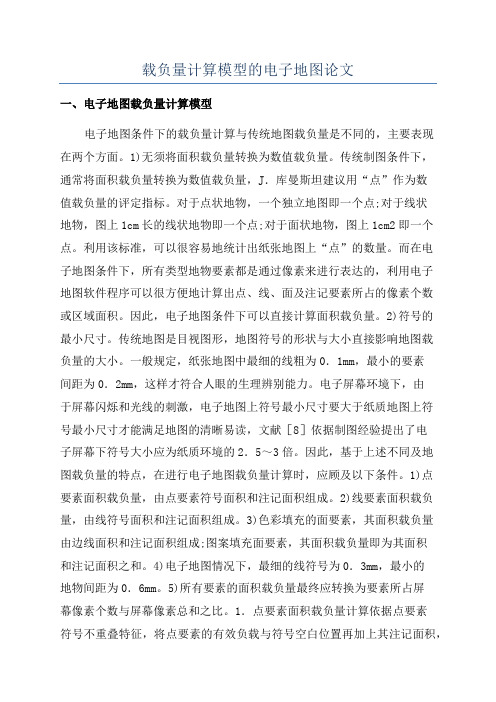
载负量计算模型的电子地图论文一、电子地图载负量计算模型电子地图条件下的载负量计算与传统地图载负量是不同的,主要表现在两个方面。
1)无须将面积载负量转换为数值载负量。
传统制图条件下,通常将面积载负量转换为数值载负量,J.库曼斯坦建议用“点”作为数值载负量的评定指标。
对于点状地物,一个独立地图即一个点;对于线状地物,图上1cm长的线状地物即一个点;对于面状地物,图上1cm2即一个点。
利用该标准,可以很容易地统计出纸张地图上“点”的数量。
而在电子地图条件下,所有类型地物要素都是通过像素来进行表达的,利用电子地图软件程序可以很方便地计算出点、线、面及注记要素所占的像素个数或区域面积。
因此,电子地图条件下可以直接计算面积载负量。
2)符号的最小尺寸。
传统地图是目视图形,地图符号的形状与大小直接影响地图载负量的大小。
一般规定,纸张地图中最细的线粗为0.1mm,最小的要素间距为0.2mm,这样才符合人眼的生理辨别能力。
电子屏幕环境下,由于屏幕闪烁和光线的刺激,电子地图上符号最小尺寸要大于纸质地图上符号最小尺寸才能满足地图的清晰易读,文献[8]依据制图经验提出了电子屏幕下符号大小应为纸质环境的2.5~3倍。
因此,基于上述不同及地图载负量的特点,在进行电子地图载负量计算时,应顾及以下条件。
1)点要素面积载负量,由点要素符号面积和注记面积组成。
2)线要素面积载负量,由线符号面积和注记面积组成。
3)色彩填充的面要素,其面积载负量由边线面积和注记面积组成;图案填充面要素,其面积载负量即为其面积和注记面积之和。
4)电子地图情况下,最细的线符号为0.3mm,最小的地物间距为0.6mm。
5)所有要素的面积载负量最终应转换为要素所占屏幕像素个数与屏幕像素总和之比。
1.点要素面积载负量计算依据点要素符号不重叠特征,将点要素的有效负载与符号空白位置再加上其注记面积,作为一个点要素的面积载负量。
2.线要素面积载负量计算线状地物要素依据其符号特征可以分为:①基本线性符号表达的线要素,如折线;②基本线符号组合表达的线要素,如平行线、虚线符号;③基本线符号加图案配置型线要素,如河堤符号。
(完整版)基于电子地图的GPS导航定位程序的设计与实现毕业论文
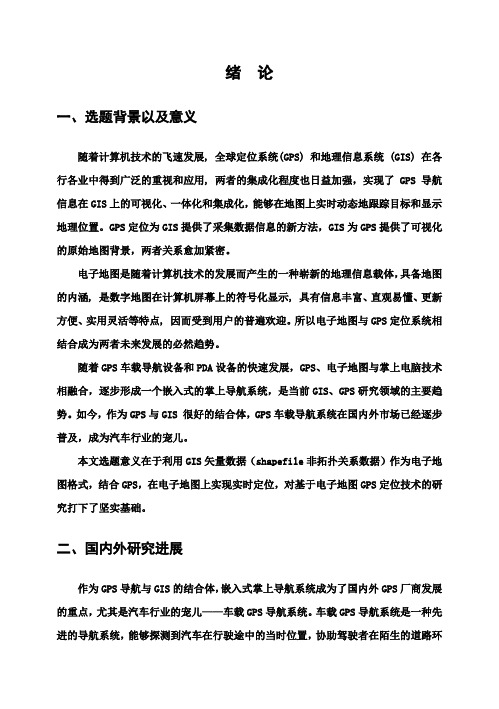
绪论一、选题背景以及意义随着计算机技术的飞速发展, 全球定位系统(GPS) 和地理信息系统 (GIS) 在各行各业中得到广泛的重视和应用, 两者的集成化程度也日益加强,实现了GPS 导航信息在GIS上的可视化、一体化和集成化,能够在地图上实时动态地跟踪目标和显示地理位置。
GPS定位为GIS提供了采集数据信息的新方法,GIS为GPS提供了可视化的原始地图背景,两者关系愈加紧密。
电子地图是随着计算机技术的发展而产生的一种崭新的地理信息载体,具备地图的内涵, 是数字地图在计算机屏幕上的符号化显示, 具有信息丰富、直观易懂、更新方便、实用灵活等特点, 因而受到用户的普遍欢迎。
所以电子地图与GPS定位系统相结合成为两者未来发展的必然趋势。
随着GPS车载导航设备和PDA设备的快速发展,GPS、电子地图与掌上电脑技术相融合,逐步形成一个嵌入式的掌上导航系统,是当前GIS、GPS研究领域的主要趋势。
如今,作为GPS与GIS 很好的结合体,GPS车载导航系统在国内外市场已经逐步普及,成为汽车行业的宠儿。
本文选题意义在于利用GIS矢量数据(shapefile非拓扑关系数据)作为电子地图格式,结合GPS,在电子地图上实现实时定位,对基于电子地图GPS定位技术的研究打下了坚实基础。
二、国内外研究进展作为GPS导航与GIS的结合体,嵌入式掌上导航系统成为了国内外GPS厂商发展的重点,尤其是汽车行业的宠儿——车载GPS导航系统。
车载GPS导航系统是一种先进的导航系统,能够探测到汽车在行驶途中的当时位置,协助驾驶者在陌生的道路环境中,通过电子地图与话音指南,准确地掌握前往目的地的路线。
它是GPS导航定位技术与电子地图技术结合的焦点。
现阶段,随着电子产和汽车产业的快速发展,国内外汽车生产商、GPS专业厂商加快了对汽车GPS导航系统研制,而我国汽车导航系统本身起步比国外要晚了许多,在各个方面存在着较大差距,下面简述国内外在该行业上的研究进展状况。
电子版论文格式模板范文(5篇)
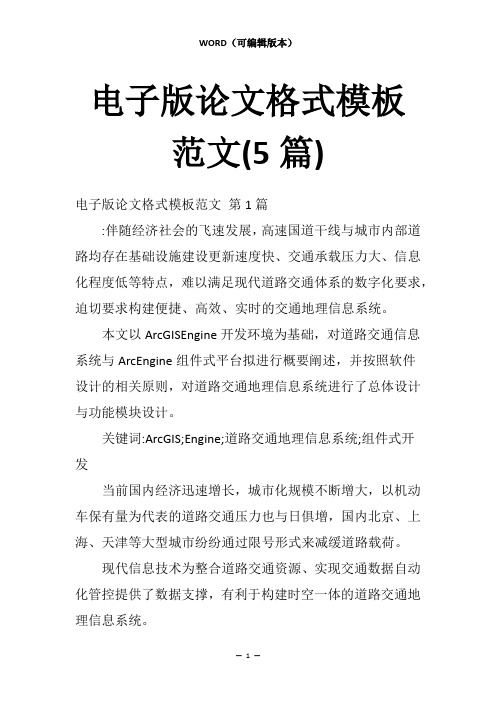
电子版论文格式模板范文(5篇)电子版论文格式模板范文第1篇:伴随经济社会的飞速发展,高速国道干线与城市内部道路均存在基础设施建设更新速度快、交通承载压力大、信息化程度低等特点,难以满足现代道路交通体系的数字化要求,迫切要求构建便捷、高效、实时的交通地理信息系统。
本文以ArcGISEngine开发环境为基础,对道路交通信息系统与ArcEngine组件式平台拟进行概要阐述,并按照软件设计的相关原则,对道路交通地理信息系统进行了总体设计与功能模块设计。
关键词:ArcGIS;Engine;道路交通地理信息系统;组件式开发当前国内经济迅速增长,城市化规模不断增大,以机动车保有量为代表的道路交通压力也与日俱增,国内北京、上海、天津等大型城市纷纷通过限号形式来减缓道路载荷。
现代信息技术为整合道路交通资源、实现交通数据自动化管控提供了数据支撑,有利于构建时空一体的道路交通地理信息系统。
1.道路交通地理信息系统ArcGISEngine作为GIS嵌入式二次开发平台,可摆脱ArcGIS提供组件式多类型开发应用程序接口API,同时可与MicrosoftVisualStu-dio系统编程集成开发环境相融合,基于进行多类编程语言下的模块式开发。
2.系统功能需求分析从应用层面分析,道路交通地理信息系统的受众群体分为交通管理方与车辆应用客户方,其中本文所探讨的基于ArcGISEngine的应用系统主要为交通管理方的C/S客户端,具体车辆客户端则可采用基于Android、ios或WindowsMobile 平台的APP软件;从系统设计的原则分析,应坚持安全性、共享性、可拓展性与可维护性的原则,提升道路交通地理信息系统的综合性发展。
作为道路交通地理信息系统,以数字化道路空间与属性信息为基础,在确保系统不同用户权限的条件下,提供地图量测、空间漫游、数据维护等功能,检索酒店、学校、商场、企事业单位相关位置,并根据摄像头监控热点交通流量、密度数据,同时借助GPS定位、无线数据传输技术,为公交、出租等公共车辆提供位置相关服务。
基于软件复用技术的电子地图应用系统研究

地 图显示模 块 、地 图功能调用模 块。军 队标号 是部 队作战指 挥 、作 战模 拟和其他军事活动 中一种常用 的图形 标号 。 军标
符号处理系统主要任务是实现军标符号 的存 储 、新建 、修 改 、
低构件理解的难度 ,避免 了由于 内部修改 而可能带来 的影 响。 符合 同一 构建模 型的要求是 构件生产 和组装 的基 础 ,构件接 口是构件 使用者理 解构建 和构件组装 的桥梁 。基于构 件的软 件开发 希望软件具有插拔性 (L G&P A ) PU L Y ,便 于替换 。
31 电子 地 图 应 用 系统 组 成 .
如软件构 件技术 、软件架构 、领 域工程 等 ,它们 结合 在一起
共同影 响软件复用 的实现 。下面就软件 的构件技 术进行 细致
探讨 : 21 构 件 的定 义 .
电子地 图应用系统 主要 由 3部分组 成 ,包 括地 图显示 系 统 ( a i ly gS s m) 军 标 符 号 处 理 系 统 ( lay M pD s ai yt 、 p n e Mit ir Sm o Ss m 和应用分析 系统 ( nls yt 。这 3部分 y b l yt ) e A a i S s m) ys e
任务管 理类主要用 于进程创建 、进程挂起 、进程 恢复 ,异常 与软件错误 处理类具有错误打印、错误记 录、错误处理功能。
33 .2关联 关 系 .
在 电子 地 图应用 系统 中 , 在各种关 联关 系 ,例 如 :空
中 目标 与区域可 以是 11的关 系 ,也 可以是 l : : n的关系 ,空 中 图 2 数据类及其子类的继 承关 系 目标与雷达可以是 nl的关 系等等 。在 电子地 图应用 系统 中类 : 之 间的关联就是各对象之 间的关系 。
百度地图API毕设论文

石家庄铁道学院毕业设计基于mysql的百度地图二次开发Secondary Development of Baidu MapBased on mysql2014届电气与电子工程分院专业电子信息工程学号20102643学生姓名杨小宁指导老师杨明完成日期2014年6月1日毕业设计成绩单学生姓名杨小宁学号20102643 班级电1004 专业电子信息工程毕业论文题目基于mysql的百度地图二次开发指导教师姓名杨明指导教师职称副教授评定成绩指导教师得分评阅人得分答辩小组组长得分成绩:院长签字:年月日毕业设计任务书题目基于mysql的百度地图二次开发学生姓名杨小宁学号20102643 班级电1004 专业电子信息工程承担指导任务单位电气与电子工程学院导师姓名杨明导师职称副教授一、设计内容基于要实现水位预警系统的远程地图显示,设计百度地图驱动mysql数据库,调用数据库里的数组,根据数据库的经纬度在地图上的相应位置显示标注,点击标注显示数据库的水深地址,以及路线查询,实现客户端手机端页面的显示等功能。
二、基本要求1、论文1万5千字以上;2、外文翻译3000字以上;3、实现java数据库驱动获取数组;4、调用百度地图API应用程序接口实现显示查询;5、实现远程查询数据;6、参考文献7篇以上,外文1篇以上。
三、主要技术指标要求1、满足Java驱动数据库准确实时的根据数据库数据的更新采集数据;2、通过百度API应用程序接口地图数据的显示查询。
四、应收集的资料与参考文献查阅关于mysql数据库的相关资料,熟悉数据库的建立流程;掌握java语言的语句编写;掌握javascript语言的编写;熟悉百度地图API功能的调用方法;规划地图开发所具有的功能和页面。
五、进度计划2014年2月~3月:总体设计实现的功能,查阅语言相关资料;2014年3月~4月:编写语言,运行测试;2014年4月~5月:调整优化,完成论文;2014年6月:答辩。
基于多源数据的防汛抗旱电子地图设计与制作
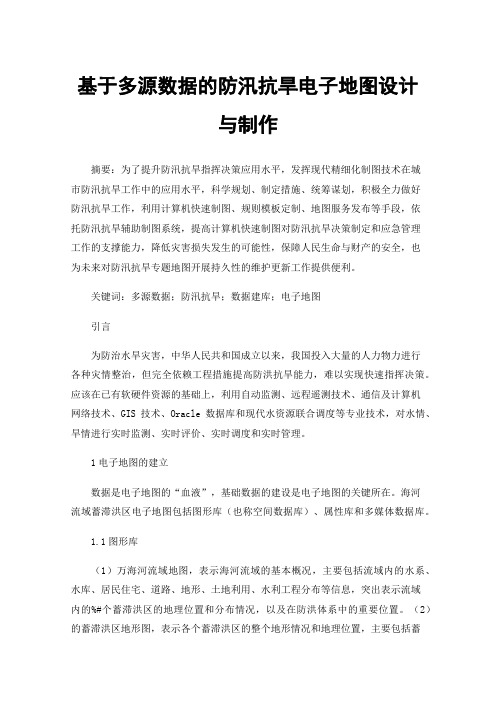
矿产资源开发利用方案编写内容要求及审查大纲
矿产资源开发利用方案编写内容要求及《矿产资源开发利用方案》审查大纲一、概述
㈠矿区位置、隶属关系和企业性质。
如为改扩建矿山, 应说明矿山现状、
特点及存在的主要问题。
㈡编制依据
(1简述项目前期工作进展情况及与有关方面对项目的意向性协议情况。
(2 列出开发利用方案编制所依据的主要基础性资料的名称。
如经储量管理部门认定的矿区地质勘探报告、选矿试验报告、加工利用试验报告、工程地质初评资料、矿区水文资料和供水资料等。
对改、扩建矿山应有生产实际资料, 如矿山总平面现状图、矿床开拓系统图、采场现状图和主要采选设备清单等。
二、矿产品需求现状和预测
㈠该矿产在国内需求情况和市场供应情况
1、矿产品现状及加工利用趋向。
2、国内近、远期的需求量及主要销向预测。
㈡产品价格分析
1、国内矿产品价格现状。
2、矿产品价格稳定性及变化趋势。
三、矿产资源概况
㈠矿区总体概况
1、矿区总体规划情况。
2、矿区矿产资源概况。
3、该设计与矿区总体开发的关系。
㈡该设计项目的资源概况
1、矿床地质及构造特征。
2、矿床开采技术条件及水文地质条件。
电子地图论文:当代电子地图质量及实践综述

电子地图论文:当代电子地图质量及实践综述作者:谢超张振辉单位:军事经济学院清晰美观的显示效果对于美观清晰的地图显示而言,一方面要求地图符号和图例制作精美以及绘制的准确性,再就是动态注记,另一方面要求地图能够内容分层显示和动态载负量调整。
对地图符号及图例可以采用图像、矢量符号来显示,图像符号可利用多媒体技术和图形图像技术制作成立体符号和阴影符号、动画符号等,使符号具有立体感、层次感、更加突出醒目,同时也增加了地图符号的种类,丰富地图的符号库,矢量符号可以采用GDI+技术来进行编程绘制,使符号更加光滑和美观[9],这些都有利于提高地图技术美,增强地图的艺术性,提高地图的审美价值。
符号绘制的准确性主要解决要素图形关系处理问题,其目的是处理好图面的一致性和可辨别性关系,信息表达和地图感受之间的关系,着重从三个方面处理:①优先级处理:地图上各地理要素从其表现形式看有一定的优先级次序,优先级高的压盖优先级低的。
屏幕显示输出优先级的确定可依以下原则进行:优先级低的面状要素先显示,线状要素次之,点状要素最后显示;对同一要素层处理时,根据目标的分类分级确定显示级别,低级别的先显示,高级别的后显示。
如变通层处理时,显示的顺序为小路、大车路、普通公路、高速公路,最后是铁路;根据不同地理要素的重要程度分为不同的要素层,次要的层先显示,重要的层后显示;②目标间关系处理:包括面与面目标,线与面目标,点与面目标,线与线目标,点与线目标之间的关系处理。
电子地图对于目标间的关系处理可以利用各要素图形间的压盖关系加上一些算法,就能达到理想的效果;③要素特征转换:由于地图显示在屏幕上的比例尺是可变的,所以必须进行地理要素图形的几何特征转换。
当显示比例缩小时,原来的线状要素(如半依比倒尺桥梁),按实际尺寸已经无法显示,必须改用点状符号,原来的面状要素(如居民地),也要变成圈形符号表示。
另外美观的地图显示还要以地图的视觉效果为显示依据。
电子地图的信息组织及可视化机制

蔡 忠 亮( 1 9 7 1 一) 。 男。 山东人 。 副教授 。 博士。 硕 士 生导 师 。 现 主 要 从 事 地
图学 、 电子 地图 。 地 图 综
合 和 GI S等 方 面 的 理 论 研 究 及 相 关 软 件 的 设 计 与开发。
Un i v e r s i t y , Wu h a n 4 3 0 0 7 9 , C h i n a )
a n d n o n — s p a t i l a d a t a o r g a n i z a t i o n ,t h e d i s s e r t a t i o n ma k e s a d e t a i l e d a n a l y s i s o n v i s u a l i z a t i o n
Abs t r ac t : Ba s e d o n s t u dy i n g o n i nf o r mat i o n o r g a ni z a t i on a n d v i s ua l i z a t i o n me c ha n i s m mul t i - me di a e l e c t r o ni c ma p,t h i s p a p e r p ut s f o r wa r d a me t h o d o f s p a t i a l i nf o m a r t i o n a nd mul t i me di a i n f or ma t i o n .I n a c c o r d a n c e wi t h c h a r a c t er is t i c s o f t h e e l e c t r o ni c ma p ,t h e p a p er a l s o p r o p os e s a
三维电子地图论文中英文资料外文翻译文献

三维电子地图论文中英文资料外文翻译文献The Design and Implementation of 3D Electronic Map of Campus Based on WEBGISI. INTRODUCTIONNowadays, digitalization and informatization are the theme of our times. With the development of information revolution and computer science, computer technology has penetrated into all fields of science and caused many revolutionary changes in these subjects, the ancient cartography also can't escape. With the technical and cultural constantly progress, the form and the content of the map change and update as well. As the computer graphics, geographic information systems (GIS) constantly applied to the Web, the conventional way of fabrication and demonstration has suffered great change, and the application of the Map has extended dramatically owing to the development of advanced information technology. Under these circumstances, cartography will be faced with promising prospect. It has branched out into many new products. One of the products come into being is the e-map [1]. With the rapid development of the computer technology, computer graphics theory, remote sensing technology, photogram metric technology and other related technology. Users require handling and analysis of three-dimension visualization, dynamic interactivity and show their various geo-related data, so much attention should be paid to the research of three dimensional maps. This article based on the Northeast Petroleum University and its surroundings designs and creates the three-dimensional electronic map.II. FUNCTIONDESIGNThree-dimensional electronic map system of campus based on WEBGIS has general characteristics of the common maps. Through pressing the arrow keys (Up, Down, Left, And Right) on the keyboard, one can make the map move towards the correspondingdirection of translation. Through dragging mouse, one can see wherever he likes. Using the mouse wheel, you can control a map's magnitude, according to the user's needs to view different levels of map. The lower left of the map where will display the current coordinate of the mouse on the map. In a div layer, we depict a hotspot of new buildings, this layer can be displayed according to the different map layers, it also can automatically scale. By clicking on hot spots, it can show the hot spot's specific information. One can also type into the query information based on his need, and get some relevant information. In addition, one can choose to check the three dimensional maps and satellite maps through clicking the mouse.Major functions:•User information management: Check the user name and password, set level certification depending on the permissions, allow users of different permissions to login the system via the Internet.•The inquiry of Location information: System can provide users with fuzzy inquires and quick location.•Map management: Implement loading maps, map inquires, layer management, and other common operations such as distance measurement, and maps zoom, eagle eye, labels, printing, and more.•Roam the map: Use the up and down keys to roam any area of the map, or drag-and-drop directly.III. THE PROCESS OF SYSTEM DEVELOPMENTTo the first, we collect the information which contains the outward appearance of architectural buildings, the shape of the trees the design of the roads. And then, we construct three dimensional scenes with 3DS MAX software [2]. That is to say we render the scene and achieve the high-defmition map, after that we cut the map into small pictures with the cut figure program, at last we built the html pages which can asynchronous load maps and achieve the function of the electronic maps. The flow chart of the system development will be shown in Figure 1:Figure 1 system development flow chartTraditional maps have strict requirements on mathematical laws, map symbols and cartographic generalization when in design. The production of network landscape electronic map also has its own technical standards which is superior to the traditional map. The three-dimensional electronic map has different zoom levels; therefore it needs not the strict scale but the unified production standards. Map symbol usually imitate the real world as much as possible and simplify itself at the same time. The scope of the screen is far greater than the fixed vision of papery maps. Cartographic generalizations think much of the balance between the abstract model and the actual performance results.As for the data acquisition and management, such as the introduction and the information users obtained from the map are final results of data acquisition. In the beginning, we collect the needed data including the name, the address, the introduction and the digital photos of the buildings and prepare for the subsequent three-dimensional modeling. After collecting the data, we should pay attention to archival and backup the files in case of loss.In order to get the map, a good preparation of the design of the standard scene is necessary. We set the parameter of the underlay, lights, altitudes, render effects and so on, so as to ensure the final fruit of our effort will have a uniform effect. The spatial entity'sperformances usually show up as the form of spot, line and surface in the three-dimensional electronic map.Compared with vector graphics, the grid graphics have unparalleled advantages. The combination of the grid graphics and the WEBGIS's background publishing technology can improve the response speed of system and save system's inputs. System achieves the interaction with the map with the JavaScript languages. Seeing that there lie differences in supporting the scripting languages on various browsers, testing all kinds of functions by different browsers is a crucial step.IV. KEY TECHNOLOGIESThe developments of three-dimensional electronic maps are inseparable with the development of related areas, and it learns research methods, techniques and tools from other areas. While the researches of other areas are directly applied to the development and construction of three - dimensional electronic map, and Computer graphics, 3-D GIS, Virtual Reality and Geographic Data Base, the modeling of virtual scene and so became the technical support of the three-dimensional electronic map system.The WEBGIS technology on which three-dimensional electronic map system of campus based is a standard Software technology which means without any commercial software's support. During the development of the system we make use of the common available technology which includes the JavaScript technology, Ajax technology, XML technology, etc.Ajax is not a one fold technology, it is a mixture which mixes multiple technologies together, including the document object which used to display on the web and its hierarchical structure document object model DOM, and CSS that used to define the elements of style, and data exchange format XML or JSON, implementation and asynchronous server of XMLHttpRequest and client script language JavaScript [3]. Ajax takes advantage of non-synchronous interaction technology which means there is no need to update pages; therefore, it will lessen the user's waiting time both psychologically and physically. That is why it will be easier to be accepted by public.EXT is an excellent Ajax framework written in JavaScript; it has nothing to do with the back-end technology and can be used to develop rich client applications with agorgeous appearance. The system enables the EXT combined with JSP to achieve the other page functions of the electronic map. The system combines the EXT with the Prototype whose framework bears the burden of creating a rich client and a highly interactive Web application, which realizes the application of the rich client efficiently and manage the safety of the client in a safe way that could be controlled.JavaScript is the principle technology of the system during the design and the implementation process. It allows a variety of tasks which can be completed solely on the client, and without the participation of the network and server which used to support the distributed computing and processing, and therefore reducing the invisible waste of resources. JavaScript allows neither the access to the local hard disk, nor the data to be saved to the server, let alone to modify and delete network documents. The single way to browse the Web information and realize dynamic interaction is through the browser, which can effectively guard against the data-loss, consequently the system reaches a high security coefficient. JavaScript can be used to customize the browser according to the diverse users, the more user-friendly the design of web pages is, the easier the method for the users to master. JavaScript technology means through the small-block approach to realize the programming. Just as the other scripting languages, JavaScript is also an interpreted language; it offers a convenient development environment.In this system, we take advantage of JavaScript scripting language to realize the key functions such as loading maps, zooming maps, geographic location, and other related auxiliary functions, i.e. map icon display, ranging, eagle eye, tags. Oracle database meets the need of the data which is used in backstage management, and together with the JSP, XML and HTML to realize the user's authentication as well as adding, deleting, revising and inquiring information’s, etc.The main function of the system is to realize the three dimensional electronic map displayed in the browser through WEBGIS technology. Owing to the combination of JavaScript technology and WEBGIS development model, we can reduce the cost of the system, and at the same time improve the interoperability and system performance. Thanks to the application of AJAX technology, we can make further improvement on loading dynamical map. All the technologies we use will reduce the reaction time, which will leave a quick and efficient impression on users.V. THE IMPLEMENTATION OF THE SYSTEMA. The fabrication of the three-dimensional scene and scene rendering for map.The three-dimensional electronic map of campus based on WEBGIS, is an electronic map system which takes the Northeast Petroleum University as the prototype. To realize this system, we should complete the fabrication of three dimensional scene and scene rendering for map, so we select 3DMAX whose operation is simple and flexible to model. Given the later needs of electronic map, the three-dimension model should be delicate as much as possible. The three dimensional model's construction would take up a great deal of time, due to so many complicated buildings of Northeast Petroleum University.To complete the three-dimensional scene we should first prepare to render the scene well. Actually the grid picture which three dimensional electronic map used is the fixed angle of view swivel eye grid map. After modeling of three dimensional spatial entities, select the appropriate rendering method and make a fixed camera angle positioning in the render (Normally at 45-degree angle ), and then set the render output parameters to render them into the camera from the perspective of fixed size picture[4].B. Loading MapIn the WEB, the maps are mainly shown through the Div layer which has three layers. One layer is used as a window the carrier of the map. The size of the layer is as large as the map which we usually see through the browser (referred to as the window layer). Another layer is the moving layer used to follow the drag of the mouse (referred to as the moving layer).The other is the covering layer which lies between the window layer and the moving layer. The map window operated by users is constituted by the three layers mentioned above. Basic operations of the map are realized through setting features in different layers [5].When loading map, we use the raster data which we usually call image data. Raster data includes image data, two dimensional map, and three-dimensional simulated electronic map. The raster data in this system is three-dimensional simulated electronic map. The abstract two-dimensional map makes some ordinary users difficult to learn the information they need, but the three-dimensional simulated map simulate the real world's information exactly, so users can easily see the real world. This system mainly displays themap picture, when you view or drag the map, it just like a complete map picture of the current window, but in fact patchwork of small pictures. These small cards are cut from complete map by the specific cutting diagram program; all the picture cards are the same size and have fixed naming rules, so the map is faster and easier to load. There are many methods to complete the map carving, the system use square slab method to cut the map to 256 pixels * 256 pixels. Then write the script which based on the naming rules to complete the picture load.C. The Basic Function of MapDragging, zooming and translation are the basic functions of the map, and they are also important features of the map that differ from a simple picture. The following is a brief description of the implementation method. To realize dragging, the first thing is to set the mouse event functions. The events include mouse down and mouse up. So the two functions combined can complete the map navigation. The mouse down event is mainly used to record the drag state as well as the present location, while the mouse up function will capture the dragging completion status, then use show map function to reload maps. Process of realizing zooming function as follows:•Gain ratio value before amplification and the proper ratio value needed to enlarge.•Calculate the coordinates of the center of the map after amplification. The formula: (point.x / oldpercent) * newpercent.•Modify icon data in the icon layer (Icon layer logical operation-Cmap _ Base.js).•Remove the current map layer, and force the memory recycling.•Load required map file.With these basic functions, the user can observe the entire campus buildings concisely and clearly. The map is divided into five zoom levels, users can zoom out to view more buildings, also can zoom in to examine the architectural details.D. Other Utility Functions1)Highlight and pop-up boxesFor some hot-query buildings, we use JSON data to create a div layer, filled with color, and then set to translucent, when the mouse moved to the layer, this area will behighlight selected. When Mouse clicks on the highlighted area, a small window will pop up showing the architectural details. Take the stadium as an example, when the mouse is not over the stadium, the building has no change, but when moving the mouse over the stadium, the outline of the building shows. When click the highlight of the stadium, the stadium will pop up some basic information’s, such as the stadium office phone, address details, the basic profile.2)RangeAs a result of mutual conversion between longitude and latitude and the campus electronic map coordinate, we can first transform campus electronic map coordinate to the latitude and longitude coordinate, then calculate the distances between two spots through their latitude and longitude coordinates, this way is simple and precise.3)Label display and hideIn order to prompt some key places in the map (such as public transportation station, street sign ), using the new layer in its label tagging, it is convenient to the user for recognize specific location, but the tagging information will affect the whole scene showing, so the user can choose displaying labels when in needed.4)Real-time coordinate and eagle-eyedThrough the eagle eye map which located on the bottom right comer of the electronic map, users can understand roughly where they are in the campus. Drag the green box in the eagle eye map can quickly locate to the site you want to. The left bottom area displays real-time coordinate value of the mouse cursor in the system.5)Inquiry and localization functionThe final designed system is easy to operate .It provides quick navigation to the home page. If you select certain types of buildings, it will list all the similar constructions on the right. Click on a building name can be fast locating the corresponding position and display information’s related to the building. The inquiry data save d in the oracle relational database, while the positioning coordinate values picked up from the JSON files. The inquiry and localization is connected through the same field name realizing the localization inquiry integration. When come to fuzzy queries, enter the keywords in the query box, all relevant information’s will be displayed. You can also enter the exact name for precise query to find the corresponding building to know more about it.VI. CONCLUSIONThe three-dimensional electronic map of campus based on WEBGIS combines the advantages of macroscopically quality, integrity, and simplicity of 2d electronic map with reality, richness and intuitive of 3D virtual scene [6]. The map system using the JavaScript technology, the XML technology, the Oracle database and other technologies realizes the information transmission and interactive operation. The system itself is cross-platform, page-friendly, security, and easy to maintain, and B/S model allows a broader user to access dynamically and operate simply.From: YiZhi-An,Yin Liang-Qun.The Design and Implementation of 3D Electronic Map of Campus Based on WEBGIS.IEEE Conference Publications .2012:577-580基于WebGIS的校园三维电子地图的设计与实现一.导言如今,数字化和信息化是当今时代的主题。
面向位置服务的电子地图系统设计研究

面向位置服务的电子地图系统设计研究摘要:本文基于笔者多年从事导航电子地图的相关研究,以LBS下的导航电子地图服务设计为研究对象,论文首先分析了系统设计的原则,进而全面阐述了具体的设计思路和功能组成,全文是笔者长期工作实践基础上的理论升华,相信对从事相关工作的同行能有所裨益。
关键词:LBS 电子地图服务系统设计LBS系统的基本原理是:当移动用户需要信息服务或监控管理中心需要对某移动终端进行移动监控时,首先移动终端通过内嵌的定位设备如GPS获得终端本身当前的空间位置数据,并实时地通过无线网络把数据上传到中心;中心GIS服务器根据终端的地理位置、服务要求进行空间分析;然后将分析结果以文本或地图的形式下传到移动终端。
因此,LBS技术是新信息技术和通讯技术(NCITS)相互融合和相互渗透的结果,其中包括了GIS技术、移动通讯技术和Internet技术等。
1 LBS下导航电子地图设计原则本文认为LBS移动终端导航地图设计应采取以下几条认知设计原则:(1)人们通过路段名字和路段节点描述路线:通过系列转向节点描述路线从一路段到另一路段,路线描述的重点是每一路段的进出节点和转向(左或右)。
地图中路段的名字有助于移动用户将地图与现实世界相联系,转向方向决定移动用户在节点处行为。
因此,节点信息是路线导航中的重要认知信息。
(2)路标是进行空间位置判断的重要元素:移动用户利用交叉路口路标和路线沿途路标可确认自己行走的路线是否准确,这大大有助于用户导航。
较大路标如水体和路线的整体形状能帮助导航者将路线与现实周围环境相联系。
同样,路段距离也有助于用户判断自己的行程,所以在导航服务地图中可标注路段长度。
(3)认知心理学的研究表明,阅读地图是获取心象地图、实现空间认知的重要手段。
不同使用目的用户对同一幅地图可产生内容不同的心象地图,而心象地图又包含诸多地理变形,心象地图包含的内容和变形完全取决于用户用图目的。
(4)移动用户的导航认知心理不仅想了解整体路线经过的所有路段和节点,而且还需准确的路线引导策略。
(通信与信息系统专业优秀论文)智能交通管理系统(ITS)中电子地图的建立及其运用
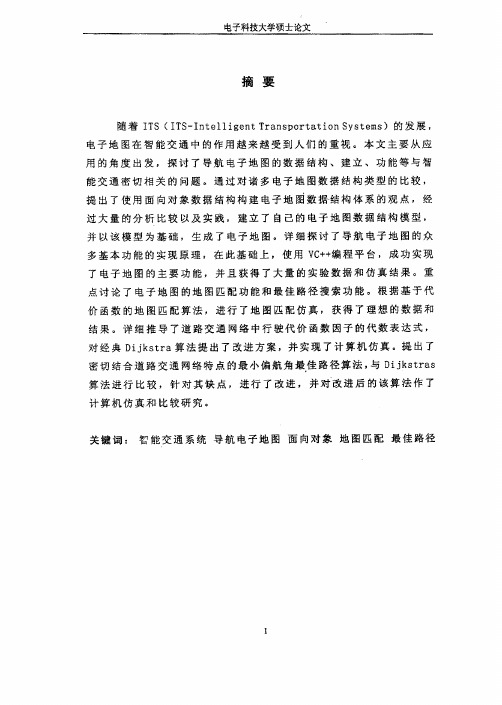
电予辩技大举硕士论文攘鬟随豢ITS(ITS-IntelligentTransportationSystems)豹发震,电子地图在智能变通中的作用越来越受到人们的重视。
本文主要从应角的角度如发,探讨了浮航电子遗图的数据结构、建立、功能等与智能交通密切相关的问题。
通过对诸多电子地图数据结构类型的比较,提如了使用面向对象数据结构构建电子地图数据-结构体系的观点,经过大量的分板比较以及实践,建立了自己的电子地图数据结构模型,并以该模烈为基础,生成了电予地图。
详细探讨了导航电子地图的众多蒸本功能的实现原理,在此蒺础上,使属Vc++缡程平台,成功实现了电子地图的主臻功能,并且获得了大量的实验数据和仿真结果。
重点讨论了瞧予遮强鲍邃强匹配凌能稳最睦爨经攫索功能。
攫握基予代价函数的地图匹配算法,进行了地图匹配仿真,歌得了理想的数据和结莱。
详缀推导了遂路交逶网络孛行鞍莰徐滔数戮子熬代数表达式,对经典Dijkstra算法掇出了改进方案,并实现了计算机仿真。
提出了密韬结合邀洚交通网络穑熹翡最套镄靛惫最佳路径舞法,葛Dijkstras算法进行比较,针对其缺点,进行了改进,并对改进后的该算法作了计算机仿真和比较研究。
关键词:智能交通系统导航电子遗蠲面向对象地图匿酝最俄路径管麓交通管理系统(ITs)中电子地图的建娃及其舔用AbsttactWiththedevelopmentofITS(ITS。
{魏teiiig嚣ntTransportationSystems),thefunctionofdigitalmapinITSisattachedmoreimportance.Basedontheuseofdigitalmap,thispaperdiscussedsomeproblemscloselyrelatedtoITSsuchasthedatastructure,constructionandfunctionsofthedigitalmap.Secondly.throughthecomparisonwithmanydatastructuretypesofdigitalmap,thispapersuggeststofounddatastructuresystemofdigitalmapby.usingdatastructureof0毯ect—Oriented。
2.5维电子地图的制作与发布

- 1、下载文档前请自行甄别文档内容的完整性,平台不提供额外的编辑、内容补充、找答案等附加服务。
- 2、"仅部分预览"的文档,不可在线预览部分如存在完整性等问题,可反馈申请退款(可完整预览的文档不适用该条件!)。
- 3、如文档侵犯您的权益,请联系客服反馈,我们会尽快为您处理(人工客服工作时间:9:00-18:30)。
导航电子地图
姓名:学号:班级:
摘要
随着社会的发展,汽车已经成为人们必不可少的交通工具,这就造成了城市中日益严重的交通和环境污染问题。
智能交通系统的产生能够减少和缓和这类问题。
组合导航系统更是陆地车辆导航定位的趋势。
在智能交通系统中,车辆导航系统是一个非常重要和基础的组成系统,是智能交通系统的中心部件。
它可以有效地利用现有的道路设施,减少交通拥挤,便于集中管理、调度。
关键词:GPS,导航,电子地图
1电子地图概论
地图的出现对人类的社会活动和社会发展产生了极大的影响,而人类的社会活动和社会发展又促进了地图的完善和发展,使它不仅能描述山川、河流和海洋等自然物貌,还能将其他诸如行政区划、人口数据、矿藏分布、经济统计数据等表现出来。
地图的发展,使它超出了纯地理信息的范畴,成为人们了解和认识世界的一个重要信息载体。
随着计算机技术的发展,为了方便地图的查询、制作、更新、复制和缩放的需求,由计算机支持的电子地图便应运而生。
电子地图是以数字形式表示的,具有在屏幕上动态显示、编辑、查询、检索、分析和决策等功能的新型地图产品。
它的出现,可以说是地图应用和发展史上的里程碑,它使地图的信息化特征得到了更好的展现和扩展,使二维的纸质地图信息向多维的空间信息发展,使孤立的地理信息能与其他社会信息相关联。
由于科技含量高以及使用便捷,它的使用范围及发挥的作用已经触及到国计民生的许多方面,前景十分广阔。
应用在政府管理与决策方面,可以最大限度地掌握所辖区域的各种信息,实现政府管理与决策的科学化;在城市规划与土地管理方面,可以实现土地管理信息的电子导航,完成各种变更管理和动态监测,实现效率最佳的宏观、中观、微观各层次管理目标,提高土地管理的科学水平;在城市公共设施管理方面,可以综合考虑规划及设计,使它们的相互干扰达到最小,效率达到最优,并发挥它们的整体优势;而以电子地图为基础的智能交通系统,借助实时交通信息、通讯网络、定位系统和智能化分析与选线系统,可以缓解道路阻塞和减少交通事故,提高驾车者的方便性和舒适性。
近几年随着计算机信息系统的出现和硬件技术的迅猛发展,以电子地图为雏形,以信息系统为支撑,综合各领域前沿的最新技术,形成了地理信息系统GIS(Geographic Information System),它为表现地理空间数据提供了强有力的平台,并能对空间数据提供动态的传输信息。
电子地图也完成了向地理信息系统的过渡。
1.1电子地图的基本性质:
(1)电子地图首先是一种模拟地图产品;
(2)电子地图的数据来源是数字地图;
(3)电子地图的采集、设计等都是在计算机平台环境下实施的;
(4)电子地图的表达载体是屏幕。
1.2电子地图的特点:
(1)数据与软件的集成性
(2)过程的交互性
(3)信息表达的多样性
(4)无级缩放与多尺度数据
(5)快速、高效的信息检索与地图分析
(6)多维与动态可视化
(7)共享性
(8)低成本性
2 智能交通系统及其发展
由于社会飞速发展,汽车愈来愈成为人们不可缺少的最常用的交通工具,这造成了日益严重的交通和环境问题。
由此产生了智能交通系统(Intelligent Traffic System)。
车辆导航定位将成为全球卫星定位系统应用的最大潜在市场之一,是智能交通系统中一个非常重要和基础的组成系统。
车辆定位是城市智能交通管理的重要内容之一。
首先是对特种专用车辆的定位跟踪,例如运钞车、救护车、救火车、公安巡逻车等。
对这些车辆往往要求实现全程监控、调度和指挥,在装备了全球定位系统GPS(Global Positioning System)卫星定位调度系统以后,可以缩短所用的时间,这对于人民的生命和财产是很重要的。
其次对于城市大量的出租车来说,装上GPS 定位管理系统,不仅可以大大增强防盗防劫的能力,而且十分有利于出租车的运营管理,可以减少大量出租车为了找用户而无目的的空驶。
这对减轻城市的车流量和减少汽车废气对城市的污染更有十分重要的意义。
对城市的公交系统来说,装备GPS 定位管理系统将可以大大提高其运营管理的智能化水平。
在车辆导航系统中,电子地图是除了车辆定位导航设备之外的最基本和最重要的组成部分。
因为车辆导航系统中的绝大部分的功能,例如车辆的定位显示、路线修正、最优路径以及各种查询功能都需要在电子地图上加以显示。
因此高质量的电子地图就成为车辆导航系统成功与否的关键。
3.GPS 基本理论
卫星定位技术是利用人造地球卫星进行点位测量的技术。
最初,只把人造地球卫星作为一种空间的观测目标,由地面观测站对它进行摄影观测,测定观测站至卫星的方向,建立卫星三角网。
这种对卫星的几何观测能够解决用常规大地测量技术难以实现的远距离陆地海岛联测定位的问题。
但是这种观测方法受卫星可见条件及天气的影响,费时费力,不仅定位精度低,而且不能测得点位的地心坐标。
因此卫星三角测量很快就被卫星多普勒定位所取代,将导航和定位推向了一个新的发展阶段。
但使用子午卫星信号进行多普勒定位时,不仅观测时间长,而且既不能进行连续、实时定位,又不能达到厘米级的定位精度,因而应用受到了极大的限制。
在20 世纪70 年代,一种全天候、全球性和高精度的连续导航定位的卫星导航系统——GPS 系统产生了。
4. GPS概况
GPS 的全称为Global Positioning System,其意为“全球定位系统”。
产生于二十世纪七十年代,是美国在继“子午仪”导航卫星系统之后,由海、陆、空三军共同研制和管理的第二代星基无线电全球定位系统,原系美国国防部全部军事系统中的一个组成部分,现已广泛应用于航海、航天、测量、运动载体监控调度等诸多领域。
GPS具备在海、陆、空进行全方位实时三维导航与定位能力,具有全天候、高精度、自动化、高效益等显著特点,成功应用于大地测量、工程测量、航空摄影测量、运载工具导航和管制、地壳运动监测、工程变形监测、资源勘察、地球动力学等多种学科,给测绘领域带来一场深刻的技术革命。
结论:
电子地图是一种以可视化的数字地图为背景,用文本、照片、图表、声音、动画、视频等为表现手段,展示城市、企业、旅游景点等区域综合面貌的现代信息产品。
电子地图是随着人类对信息需求的不断增加,纸质地图的有限空间越来越难以满足人们的需求,应运而生的。
在车辆导航系统中,电子地图是除了车辆定位导航设备之外的最基本和最重要的组成部分。
因为车辆导航系统中的绝大部分的功能,例如车辆的定位显示、路线修正、最优路径以及各种查询功能都需要在电子地图上加以显示。
因此高质量的电子地图就成为车辆导航系统成功与否的关键。
参考文献
1.左伟,GPS 技术及其在导航电子地图中的应用,2003,5
2.GPS 理论与应用(第1 卷),西安导航技术研究所,1999。
6
3.GPS 理论与应用(第2 卷),西安导航技术研究所,1999。
10
4.李振龙,GPS/电子地图车辆导航系统研究,2001,3
5.赵兵等,GPS 车辆定位导航系统中电子地图的设计,V ol8,No.4,2000。
